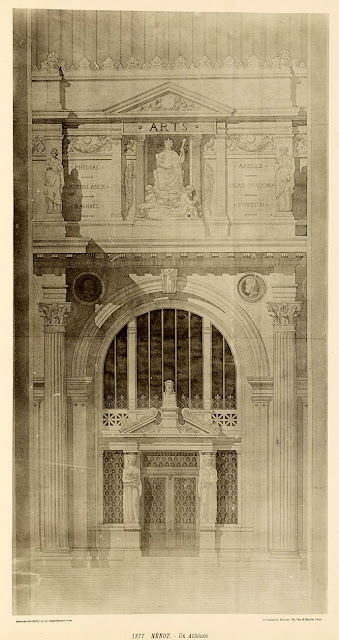These plans for unbuilt monuments come from Archi/Maps, a wonderful web site. The plans were recovered from the archives of Parisian printing firm of E. Le Deley. They are by various architects, usually identified only by last name. Above is a plan for a "Monumental Necropolis" by Quatesous, a person Google does not recognize, 1883.
A gigantic monument to Joan of Arc by Emanuel Pontremoli, 1890.
A parliament building by Huguet, another mystery man.
Temple to the Sun by Gerhard, 1865.
And an Athenaeum by Henri Paul Nénot, 1877.
Monday, December 23, 2019
Subscribe to:
Post Comments (Atom)











3 comments:
Above is a plan for a "Monumental Necropolis" by Quatesous, a person Google does not recognize, 1883.
...are we sure it's actually a real surname?
Because it's very close to Quat'sous, or Quatre Sous - literally "four sous", with a sou being a "solidi", a smaller denomination of French coin valued at one twentieth of a livre, itself worth a troy pound of silver.
There is a historical English idiom of "threepenny" to mean that something is a trifle or inexpensive, and "Quatre Sous" or "Quat'sous" essentially the French equivalent.
Thus, I'm wondering if this is some sort of colorful nom de plume? A bit of self deprecation, perhaps? Maybe some then-topical reference, or perhaps a subtle pun?
So on a whim I decided to Google as if this were a real surname, and just plugged in a random French given name. "Henri Quatesous" clearly isn't the actual name, but through some quirk of search engine algorithms and luck it seems I may have stumbled on something anyway with that as my search term.
I got two partial matches for Google books that mention "Quatesous (Léon-Eugène-Edouard)". The first one puts us in the right time period, Salon de 1885: cent planches en photogravure.
The second one, L'Exposition des beaux-arts, mentions "MM. QUATESOUS (Léon-Eugène-Edouard)" among several other names (each seeming to be an assumed name followed by an actual name in parentheses), under the headings "SECTION D' ARCHITECTURE" and "MÉDAILLES DE PREMIÈRE CLASSE".
The third and fourth results both were for an English language source, and directly mention Quatesous as one of two architects who worked on this design in 1883. The relevant excerpt:
"The Ecole des Beaux-Arts and the Prix de Rome. There are three kinds of designs which win these famous prizes, the brilliant, the clever, and the serious. To the first belong such remarkable designs as the Etablissement de Bains by Moyaux 1861, the Hotel pour riche Banquier by Pascal, 1860, the Palais des Beaux-Arts by Bénard, 1867, the Cathedral by Laloux in 1878, the Palaid-Cercle des Beaux-Arts by Deglane, 1881, the Nécropole by Redon and by Quatesous in 1883, the Musée d'Artillerie by Bertone in 1892...."
It seems this Léon Eugène Edouard won at least one high level award for his architectural designs, and "Quatesous" was his... not quite pen name, but... drafting name, I suppose?
It's clear that the name "Quatesous" was recognizeable enough that people didn't feel the need to include his actual name all the time - a "Voltaire" to his "François-Marie Arouet", so to speak.
So the other architect, Gaston Redon, is apparently much easier to find - he has a wikipedia entry.
https://en.wikipedia.org/wiki/Gaston_Redon
Presumably this is because, although I was not already familiar with him, it seems he was a rather big deal - a friend of Claude Debussy and the official architect of The Louvre are pretty notable bragging points.
Post a Comment